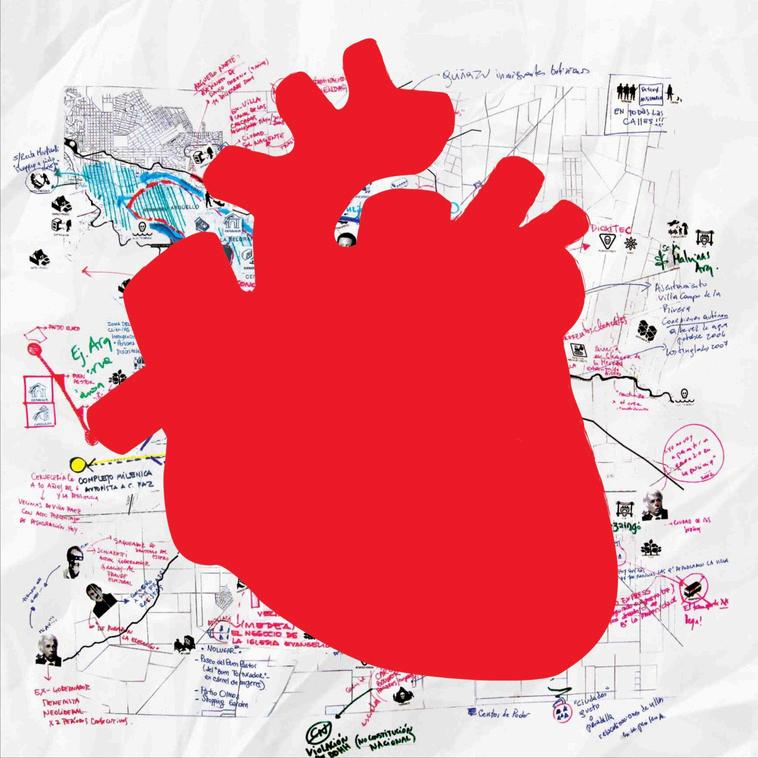

AlonsoWashington Practical guideto understand Querétaro urbanmodel

PHENOMENA
Criticalandcartographic resourceforterritorial insight

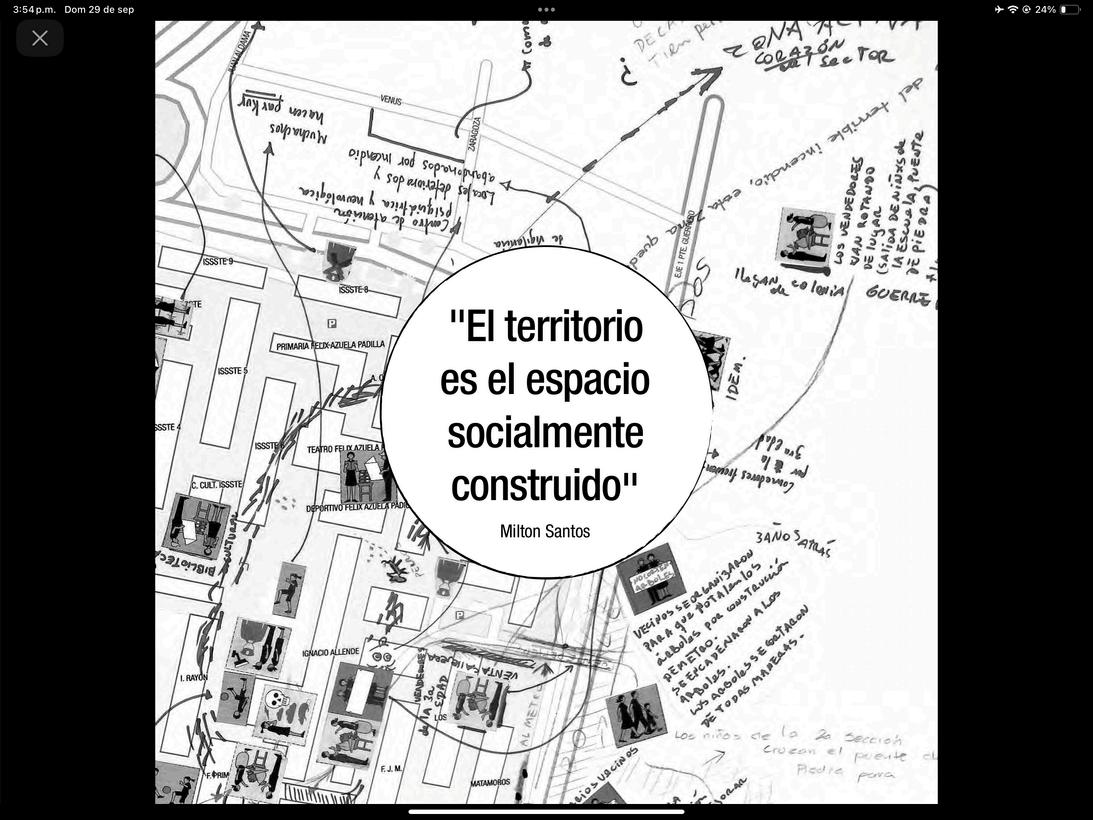
“First we design our cities, then they design us”
Winston Churchill
2
4
6
01 02 03 0
LatinAmericancitymodels
Structural model of medium citiesinMexico
Querétaro: between historical prominence and accelerated urbangrowth
The city of between stru restructuring
06
f Querétaro: ucturing and
New features in the sociospatialstructureinQuerétaro
Changes in the urban layout anditsresultingimage
Conclusions: new elements in theLatinAmericancitymodel?
LatinAmericancitymodels
Experts in sociology, economics, architecture, urban history and other disciplines have again and again developed descriptive-analytical or normative models of cities that serve asatheoreticalbasisforthiswork
The order in circular forms: An arrangement in the form of rings towards the interior already drawn in thecolonialera.
Adivisionintosectors:The scheme of concentric circles is transformed by a youngerandsectoralorder.
Urban enlargements in the form of cells: The ordering in the form of rings and the arrangement in overlapping sectors will be modified especially on the periphery of the city by means of expansionintheformofcells.
Figure1 ModeloftheLatinAmericancitybyJ Bähr,A BorsdorfandG MertinsSource:inGaebe,W (2004) UrbaneRäume,UlmerVerlag:Stuttgart,p 258

Center
Subcenters
Mixed-use area
Industrial area
Residential areas
Upper class
Middle class
Lower class
Social interest housing


Marginalized colonies
- central ("Slums"):

Old degraded areas of the upper middle class
Older areas for the masses
Illegal and semiillegal charbolas in the periphery:
Illegal charbolas
Illegal and semi-ille-gal charbolas
Predominant movements
Structural model of mediumcitiesinMexico
In contrast to the model of the Latin American city, the structural model of medium-sized cities in Mexico is based on the colonial urban layout in the form of a chessboard and describes the following phases of development
The traditional city: Starting point for thenewgrowth,carefullyexpanded.
The fragmented city: The uniform and orthogonal reticular frame dissolves in a fragmented city and in a strong growthofsurfaces.
The conurbation: As a result of the strong spatial expansion, the empty spaces of growth will be densified, the first periphery will be consolidated and the suburban areas and neighborhood communities in the urban area will be integrated.
Figure Structuralmodelofmedum-sizedcitiesinMexico SourceEinsele,M,Gormsen,E,Rbbeck,E,Klein-Lüpke,R (editors)(1994) SchnellwachsendeMittelstädteinMexiko, InstituteofUrbanismoftheUniversityofStuttgart:Stuttgart, p 36

Thetraditionalcity
Thefragmentedcity
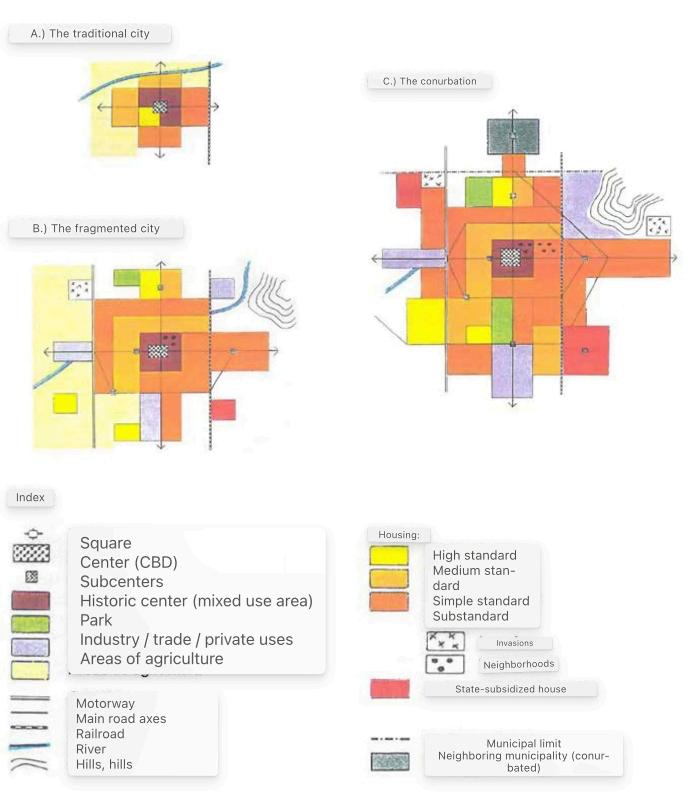
Theconurbation
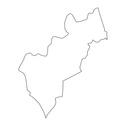
Querétaro
SantiagodeQuerétaro
Foundation:1531
Population:2368467
Municipalities:18
Surface:363km²

The state of Querétaro is one of the smallest states in the country and is divided into 18 municipalities. The city of Querétaro is located in the southwest of the state in the Central Region and is surrounded by the municipalities of Santiago de Querétaro, Corregidora, El Marqués and Huimilpan. In 2005, the statehadatotalpopulationof1,598,139.
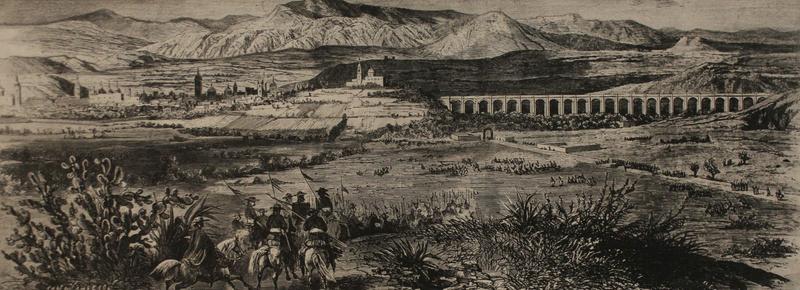
Asastate,QuerétaroisconsideredareflectionofMexicanhistory,sincetherebeganin1810the uprisingsagainstthedominationoftheSpanishcrown;38yearslater,in1848,theMexican-American warendedwiththesigningoftheGuadalupeHidalgoTreatyinthecityofQuerétaro,withwhichMexico lostabouthalfofitsterritorytotheUnitedStatesofAmerica In1867intheCerrodelasCampanaswas executedbyorderofPresidentBenitoJuáreztheimposedArchdukeMaximilian,EmperorofMexico Aftertheriotsofthewar,theConstitutionofmodernMexicowasdraftedandpromulgatedin1917.
Querétaro: between historical prominence and acceleratedurbangrowth
Today the city of Querétaro, capital of the state, due to its geographical location, has a link function, since it has connections to both Mexico City andtheBajío.
While trade and services are oriented towards the characteristic agricultural sector of the Bajío, Querétaro is industrially directly related to Mexico City, so that the city represents an importantcommunicationsnode
From these antecedents, it shows that in the Querétaro was a continuous increase in both physical and demographic.
The growth of society is also observable in Querétaro, where the large number of citizens of working age represents greater demand and new challenges for the future labor market.

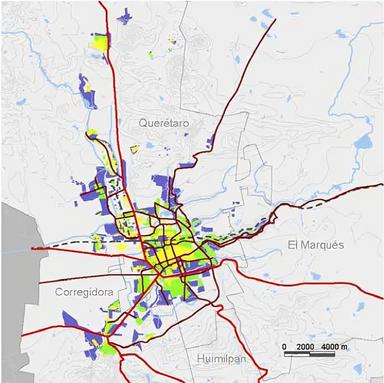

1970:1,042,000
1980:2,890,600
1990:6,429,530
1970:1,042,000
1980:2,890,600
Withregardtodensity,theaveragenumberoffamiliesandtheunstoppableentryofthecarintoMexican society have led to the transformation of the urban structure, since large intra-urban distances could only be traveled if a private vehicle is available However, the fragmentation of the urban form imply a failureofrelativeprofitability,thatis,tracesofinfrastructureorlongroads
The city of Querétaro: between structuring and restructuring
The transformation of the traditional city led to an urban system that is structurally reminiscent of a patchwork or puzzle carpet, whose elements represent construction standardsordifferentsocialgroups
However, it is still observed that spatial expansion occurred mainly in concentricform.
Within the framework of the conurbation it can be observed that, in addition to an expansion from the interior to the outside, there is an opposite development that generates animplosionofQuerétaro
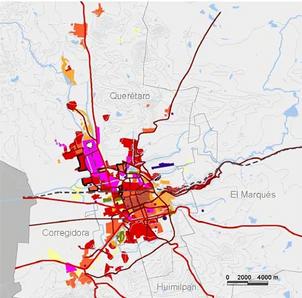
Querétaro:Urbanstructure1990

Migration Center
Municipalcentres
Sub-centres
Satellites
Industry
Regionalequipments
Municipalborders
Regionalhighways
Railway
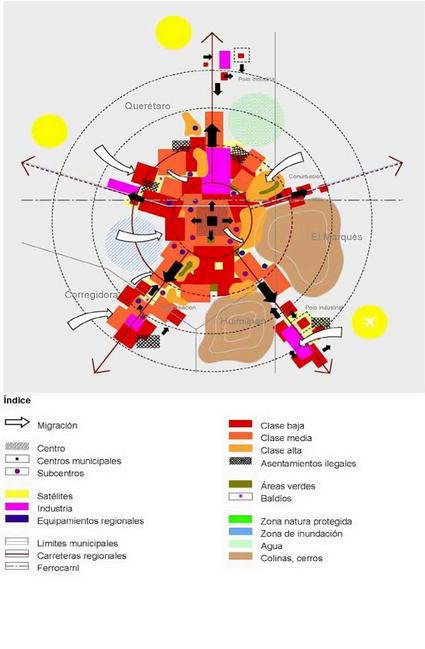
StructuralschemeofQuerétaro,2005
Upperclass
Mediumclass
Lowerclass
Illegalsettlements
Greenareas
Wastelands
Protectednaturalarea
Floodzone
Water
Hills
New features in the sociospatial structure in Querétaro
Socially and spatially, the area of the urban agglomeration of Querétaro is characterized by a growing segregation that makes other cities see within a city, that is, the city is not divided like, for example, Mexico City into the rich and poor sectors; instead, the independent development of the city of Querétaro is heading towards a puzzle of poor sectors, middle class sectors and sectors of wealthier population.
The concentric or limited distribution by nearby colonies of the social strata in the traditional city has been modified as a result of industrialization The rapid separation of places of residence and work has led to a rigorous segregation, which derives from the difference in income andsocialpositionoftheinhabitants.

Mexico:inequalityandindividualismbyMarianaOrdoñez

Ontheotherhand,thedesireforsocialexclusivityresultsintheabandonmentofpublicspace.The streetsareblocked,highwallsandmulti-levelbuildingswithsecurityservicesinstalledarebuiltandasa resultisolatedandincommunicatedcities. TheimpossiblemissiontocrossastreetbyRebbeccaBlackwell
Changes in the urban layout and its resulting image
With regard to its orthogonal layout, organized in colonial times, it was not until 2005 that it was lost in the urban systemofQuerétaro.
Instead of this is a chaotic carpet of scraps that geometrically and organically orders the construction surfacesofdifferentsizes.
The urban layout is impregnated, through the contrasts, with samples of formalandinformalurbanization,witha result of informal urbanization similar tothatofMexicoCity.
While informal housing areas are built on a rectangular basis, formal colonies are mainly built on the basis of individualandirregularforms.

ThepopularcolonyLomasdeCasaBlanca isorganizedinarectangularway OrganiclinesintheurbanlayoutoftheEl CampanarioGolfClub.


SchematiccutthroughthefabricofthecityofQuerétarointheformofaplateindicatedwithclimbingheights-fromthecentertotheperiphery
Finally,intermsofitsurbanimage,Querétaroseekstopresentitselftotheglobalizedworldasan internationalcityofprogressontheonehand,andontheotherittriestogivetheimageofidentityof anancientcityandforthisitattendstoitshistoricalheritage.ThefactthatthecityofQuerétarohas expandedhorizontally,insteadofhavingdensifiedorgrownhigh,allowsthefuturecityofonemillion inhabitantsnottohaveametropolitanimage.
Conclusions: new elements in the Latin Americancitymodel?
Instead of physical growth being reduced or totally stopan and the city being 'filled' again, Querétaro expanded even more spatially in relation to its demographic growth, and an end to urban expansion is not expectedonacontinuousbasis.
However, the growing dispersion of the city's body is questionable, because both the decrease in density and the fragmentation of the urban form imply a failure of relative profitability, that is, traces of infrastructure or long roads In this way, we have to expect densification processesinthecitycenter.
On the other hand, the policy of neoliberalism focused on economic progresscausesenormousdamageto theenvironment.
Querétaro today represents a typical industrialcityoftheearly21stcentury, in which tradition, modernity and poverty often confront each other directly.
1979 Graciela Iturbide/Courtesy of the MuseumofFineArts,Boston
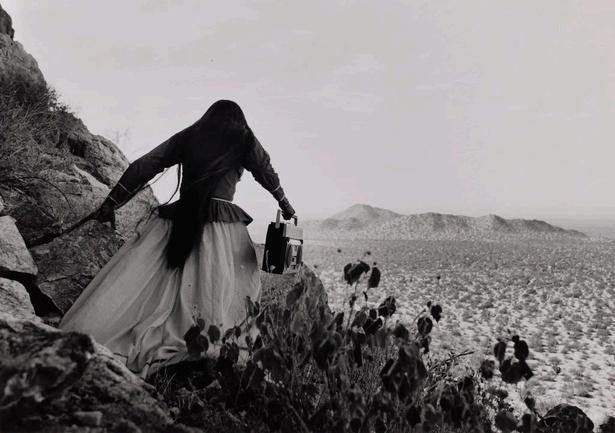



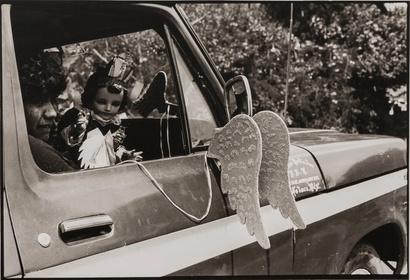
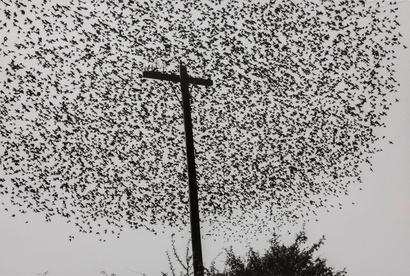

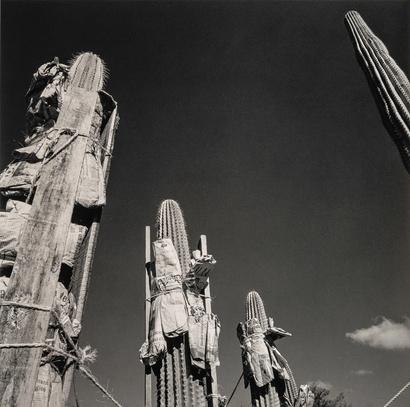
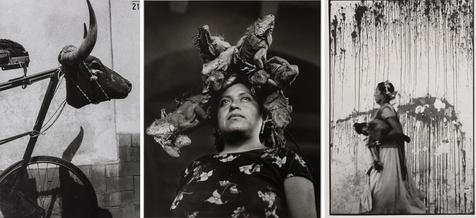




How does transportation influence accessibility in the city?
How can we balance growth with sustainability in Querétaro?
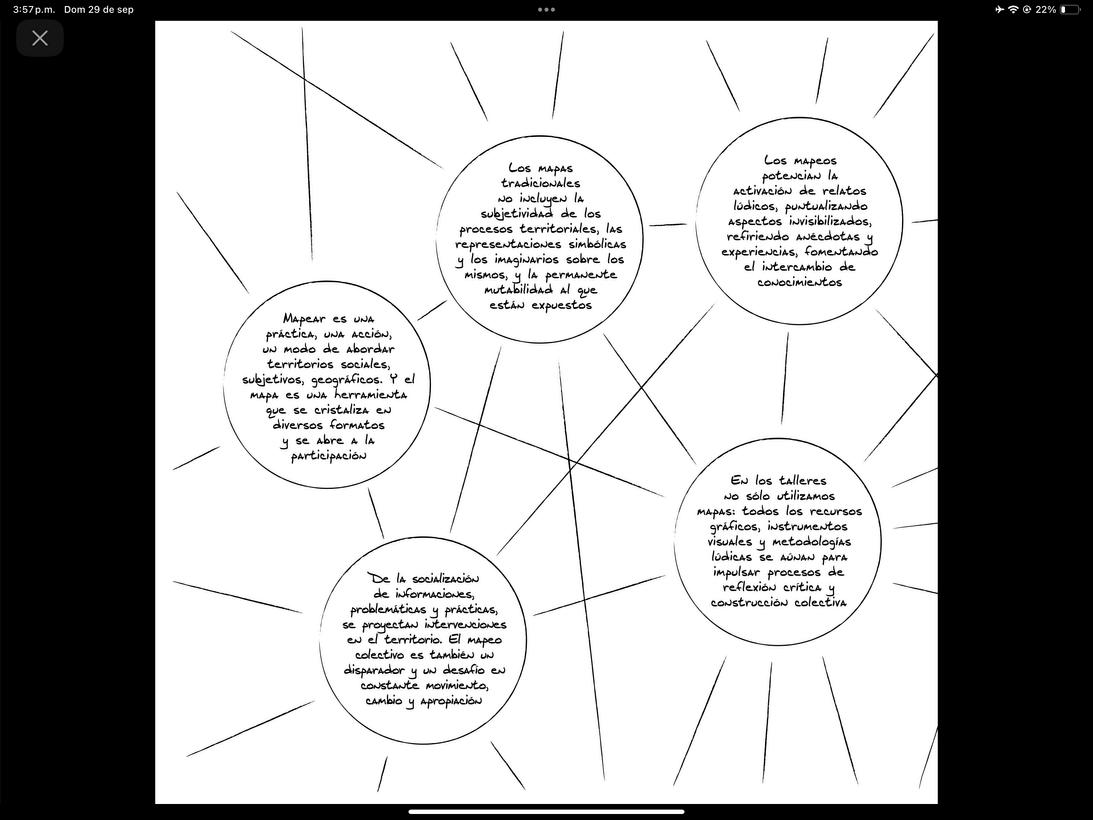
What role do public spaces play in community interaction?
What is the long-term impact of urbanization on local culture?
How can we ensure affordable housing amidst rising costs?
What are the potential benefits of preserving historical sites?

How can technology improve urban management in Querétaro?
Questions for Reflection on Urban Development
How does climate change affect urban planning decisions?
What strategies can enhance citizen engagement in urban development?
What can be done to foster inclusive communities in a rapidly changing city?
Alonso Washington
Bibliography
BRILLEMBOURG,Alfredo,FEIREISS;Kristin,KLUMPNER,Hubert(editors)(2005) InformalCity,CaracasCase,PrestelVerlag: Munich,Berlin,London,NewYork
IIIII
EINSELE,Martin,GORMSEN,Erdmann,RIBBECK,Eckhart,KLEIN-LÜBKE,Rainer(editors)(1994) Schnellwachsende MittelstädteinMexiko,InstituteofUrbanPlanningoftheUniversityofStuttgart:Stuttgart GAEBE,Wolf(2004).UrbaneRäume,UlmerVerlag:Stuttgart,2004 GÖBEL,Christof(2009):StrukturwandelurbanerAgglomerationeninMexiko,1990–2005–FallstudieQuerétaro,doctoral thesis,InstituteofUrbanPlanningoftheUniversityofStuttgart,in:URN:urn:nbn:de:bsz:93-opus-39023,URL:http://elib.unistuttgartde/opus/volltexte/2009/3902 HUMPERT,Klaus(2005).Thegreateraoftheurbanizationoftheworld,in:Krieger,Peter(editor).Megalopolis,The modernizationofMexicoCityinthe20thcentury,NationalAutonomousUniversityofMexico,InstituteofAestheticResearch: MexicoDF,pp 55-71
RIBBECK,Eckhart(2005).Theworldbecomescity,cityscapesfromAsia,Africa,LatinAmerica,Jovis:Berlin
